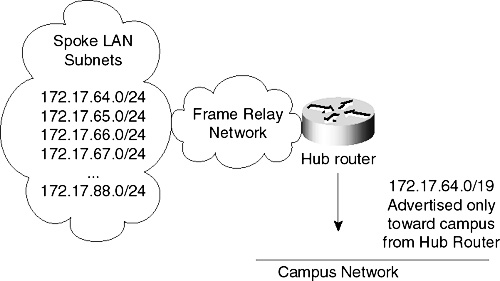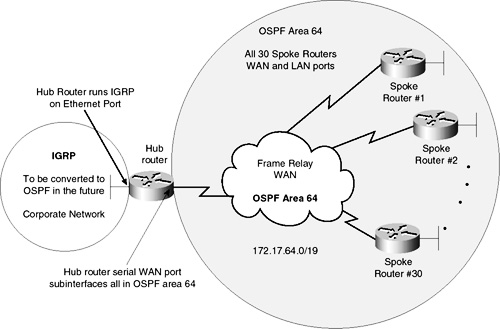Designing Implementing an OSPF Network
Wide Area Network Design RequirementsTerrapin wants to remove the leased lines and 3174 cluster controllers and network its sales offices using public Frame Relay service. The new WAN must seamlessly integrate into the existing corporate internetwork.
As the design engineer, you are responsible for the OSPF design and implementation, TCP/IP addressing scheme, and router implementation of this frame relay network. To construct a scalable OSPF network capable of meeting both the present and future requirements, you need to gather the necessary information from the appropriate company decision-makers. This information will consist of determining the customer’s requirements as discussed in the following section. Determining the Frame Relay PVC Architecture The corporate engineering group has control of all circuit and transmission architectural decisions such as the planning and ordering of all data and voice lines, as well as equipment procurement and installation. You are told that the new frame relay topology will be a partially-meshed hub and spoke. Figure 7-26 illustrates this topology.
Each spoke or remote sales office will have a 56KB local circuit installed into the frame relay POP with a single 32K CIR PVC provisioned to a T1 circuit which will be installed on a central hub router at the corporate Headquarters and data center facility in Tennessee. The CIR on the T1 circuit will be 384K. Determining if There Will Be Multi-Protocol Support The WAN network must support Novell IPX in addition to TCP/IP since it is on the customers’ LANs. The corporate IS manager indicates that no native SNA will need to be supported on this network as all the IBM 3174 controllers will be removed after conversion to frame relay. Mainframe access will be accomplished using TCP/IP directly from terminal emulation software running TN3270 (Telnet) at the Regional Sales Offices Determining the Application Data Flow The IS manager tells you that the majority of traffic on this frame relay network will flow from individual branches to corporate HQ, in the form of PC-to-mainframe communications. It will be necessary for certain sales offices to share and print files on remote Novell Servers and printers. All remote sales offices are located in the Northeastern and Southeastern US. Determining the Number of Routers There will be 25 routers on this frame relay network with a potential 10% increase (3 routers) over the next three years (one location per year). The existing corporate network has 30 Cisco routers deployed, servicing 50 TCP/IP subnets and IPX networks on an Ethernet infrastructure. Determining TCP/IP Addressing Terrapin Pharmaceuticals is allocating TCP/IP addresses from the private RFC 1918 space. All existing LANs are subnetted out of 172.17.0.0 space using 24 bit prefixes. (/24 prefix or 255.255.255.0 subnet mask). IP subnets currently allocated on the corporate network are 172.17.1.0-172.17.55.0. You are told that you must support between 50 and 150 IP hosts per remote Sales LAN from unused subnets out of this same address space. Determining Internet Connectivity Terrapin Pharmaceuticals currently has Internet connectivity through a firewall segment. The default route or “gateway of last resort” is propagated into IGRP from a central router on the internal network to all other IGRP-speaking routers. A registered class C address has been obtained and is deployed as the Internet DMZ segment. This is the only address that is announced to the Internet from Terrapin’s Internet Cisco 4700 router, as the firewall has proxy and Network Address Translation (NAT) capabilities. Determining Enterprise Routing Policies After speaking with the managers of the IS department, you discover that they intend to migrate the network from IGRP to OSPF on the existing Cisco router base in the near future. Thus, the frame relay network must run OSPF and integrate seamlessly into the eventual corporate OSPF network architecture. Because no timeframe for the campus OSPF conversion can be determined, your network must integrate into the IGRP network upon installation for an undetermined period of time. Establishing Security Concerns The company plans to use OSPF password-authentication when the network is converted to OSPF from IGRP. The security manager indicates that a single password will be sufficient across all OSPF-speaking router links. After evaluating all of Terrapin’s requirements, Figure 7-27 illustrates the proposed OSPF network design.
OSPF Network DesignThis section will discuss some of the design topics to consider within this case study. TCP/IP Addressing You are able to obtain a contiguous block of 32 “class C” (/24 or 255.255.255.0 mask) subnets for this network from the IP address manager. The address block is 172.17.64.0/19, which will allow clean summarization into the backbone area once the corporate network converts to OSPF. (This occurs because all of the frame relay network LAN and WAN addresses will be summarized as one route (172.17.64.0/19) once the backbone routers are converted to OSPF as show in Figure 7-28.)
|
EAN: 2147483647
Pages: 200


